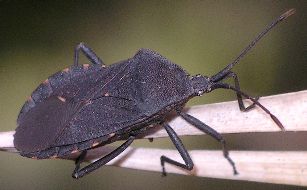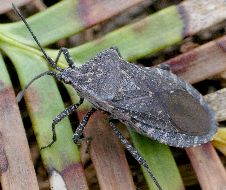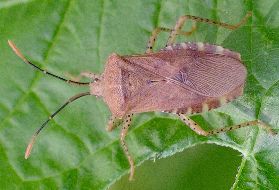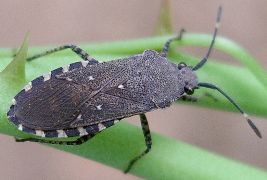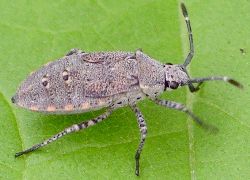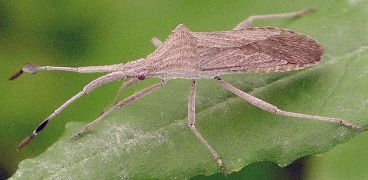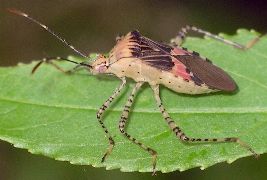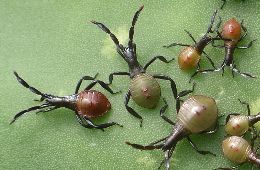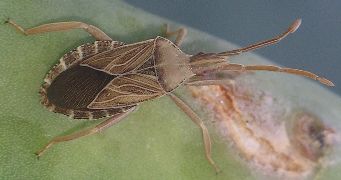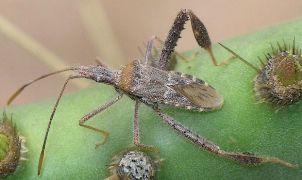
| Coreidae ~ Leaf-footed Bugs |
page 1 ![]() page 2
page 2
|
The genus Anasa contains the true squash bugs. These are not large insects, being about 12-14 mm in length. They feed on both cultivated and wild members of the Cucurbitaceae family. There are three species in our area, but I have only been able to identify Anasa tristis because it is the most common pest in gardens, and can often be found in small groups. The other two species are quite distinctive: one is light colored and the other is nearly solid black with small orange stripes on the sides of the abdomen. A. tristis is rather variable, but is generally mottled in gray and black. The young nymphs are whitish with black legs. They sort of look powdered at first glance and when viewed closer have a beaded appearance.
Not many of the coreid bugs have common names. Chariesterus antennator, however, is called the Euphorbia Bug, because of its preference for members of that plant family. It is a small insect, at only about 11 mm in length, and is covered with a gray "pelt." Its antennae, which are placed very close together on the front of its head, have a black widened area near the tip, hence the species name. The nymphs look very different from the adults and are green with brown spikes all over their edges. Their antennae are very wide and dark brown.
Possibly the most common species of coreid in our area is Hypselonotus punctiventris, which is quite a mouthful and it would be nice if it had a common name instead. This species favors plants in the mallow family, but will also feed on a wide variety of fruits, leaves and flowers. The insects are usually about 13 mm in length, with very slender legs. They are colorful, ranging from tan to pink with dark brown stripes and markings. Although they might be numerous at times, they do not seem to do much damage to the plants on which they feed. Nymphs have very large and thick antennae, which they often hold out in front of their heads at downward curving angles. They look amazingly like the front legs of spiders! When the adults fly, their spread wings reveal a brilliant red color on the top of the abdomen, which is quite a surprise.
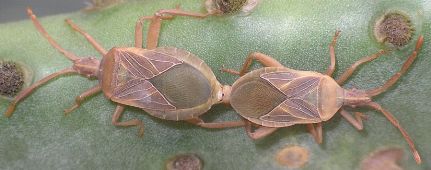 Chelinidea vittiger mating Sometimes there is a more flattened, lighter green nymph with light tan legs and head crawling among the masses of dark ones. This is C. tabulata, not to be mistaken for a freshly molted individual of the other species (they are usually bright red). Chelinidea tabulata is a more southerly species not particularly common here, and they are also not found in large homogenous groups. They will mingle, though. I've never found more than two nymphs at a time or one adult. The damage caused by Chelinidea feeding doesn't hurt the plants but it makes ornamental cactus plants very unsightly because of the discoloration on the skin.
One other kind of cactus bug is common on prickly pear. This is a more traditional leaf-footed bug called Narnia femorata. Adults are not very large and rarely reach 13 mm in length. They are sort of hairy looking and their pronotum is a rust color. They might be confused with Leptoglossus but the "leaf" of their tibia is not as pronounced. Nymphs are dark brown and tan, with noticeable spikes on their abdomen.
|
page 1 ![]() page 2
page 2
![]()
